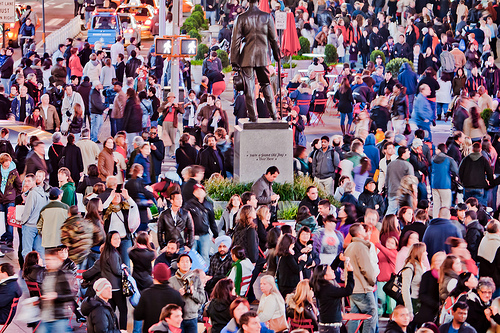
A few weeks ago, I flew from the wide open spaces of Grand Junction, Colo., to New York, the city I now call home. Air traffic at LaGuardia airport had delayed my flight two hours and still the pilot had to circle several times before we received clearance to land. I was late, I was crabby, and I just wanted to be home. So you can imagine my frustration when I stepped out of the airport and into the muggy night to behold the scene below.

Cassandra Willyard
Yes, folks, that’s the taxi line. It snaked down the sidewalk and then doubled back on itself. The queue was so long I couldn’t see the turnaround point. I snapped a photo and posted it to Facebook. “Welcome back to the big apple, Cassie! Here’s your taxi line,” I wrote. Five [expletive] minutes in New York and already I was cursing and scowling.
LaGuardia is notorious for delays and lines, but there’s a deeper, more basic problem — New York has too many people in too small a space.* It’s super dense. Fun fact: If you could convince the entire world to live like New Yorkers, you could pack all 7 billion of us into the state of Texas. That might be good for the environment, but what about our mental health?
New York is a 24/7 stress fest. Try muscling your way through the tourists packing Times Square or cramming yourself into an overstuffed train. I dare you to walk down Canal Street (home of knock-off Fendi, Prada, and Gucci) without wanting to knife someone. I’ve tried, and I can’t do it. And then there is the constant ear-splitting noise — horns, sirens, animated cell phone conversations. The city is relentless.
Maybe I don’t have the right attitude — the right constitution — for New York. I’m impatient and short-tempered, and New York exacerbates those tendencies. But other New Yorkers seem impatient and short-tempered too. Is it us, or is it the city? Could urban living be harming our brains?
Jonah Lehrer says yes. Here he is in a 2009 story for the Boston Globe:
Scientists have begun to examine how the city affects the brain, and the results are chastening. Just being in an urban environment, they have found, impairs our basic mental processes. After spending a few minutes on a crowded city street, the brain is less able to hold things in memory, and suffers from reduced self-control. While it’s long been recognized that city life is exhausting … this new research suggests that cities actually dull our thinking, sometimes dramatically so.
Not all of the research points that way, of course. (What? You were expecting an unequivocal “yes” from science? Fat chance!) But a surprising amount of it does.
Several studies seem to suggest a link between city living and mental illnesses. A 2001 study found that schizophrenia was twice as common among people born and raised in large cities compared to people from rural areas. And it makes some sense that growing up in a city could impact how your brain develops. But I was born in North Dakota. I didn’t grow up urban. I want to know how city living impacts my hamlet-grown brain. A PubMed search uncovered several articles. The most intriguing was only available in Portuguese. But the translated title gives you the gist: “Urban health: The city is a strange lady, smiling today, devouring you tomorrow.”
Finally I stumbled across a relatively recent study that promised to provide some answers. The researchers recruited 32 German students from rural areas, small towns, and cities, and put them in an FMRI machine to scan their brains. They asked the students to solve timed math problems that grew increasingly difficult. When the students got the wrong answer, as they often did, the researchers criticized them. (My worst nightmare looks a lot like this scenario.) The task was designed to stress the participants out. And, not surprisingly, it did.
This “social stress” made many regions of the brain light up, but only people currently living in cities showed increased activity in the amygdala, an almond-shaped structure involved in fear and anxiety. Allison Abbott writes, “The initial experiment showed such clear associations that [Andreas] Meyer-Lindenberg didn’t think anyone would believe them. So he did a similar experiment on another 23 subjects, this time adding visual feedback that allowed participants to see the investigators’ frowns. He found the same sturdy associations.”
What that finding means isn’t yet clear. Blogger Scicurious points out:
We don’t know what the change in activity is doing, what effects it’s having. There were no differences in behavior, blood pressure, etc, etc. Without a behavior to go with it, it’s just a brain scan showing increased activity, and very little can be concluded from it.
There’s another problem: The authors define a city as having more than 100,000 inhabitants. But living in a city of 110,000 is nothing like living in a city of 8 million. The stressful situations I encounter on a daily basis in New York are almost unheard of in Fargo, N.D. (pop. 107,000).
And what about individual variability? As Daniel Kennedy and Ralph Adolphs, who wrote about the study in Nature, point out, “There are wide variations in individuals’ preferences for, and ability to cope with, city life: some thrive in New York City; others would happily swap it for a desert island.”
Perhaps I’m just in the wrong habitat. But how do I find the right one? Moving back to North Dakota would surely precipitate a mental health crisis (not to mention raise questions about my sanity).
Of course, I’m not blaming all of my angst on New York. If I’ve learned anything in the past three decades, it’s that I have a boundless capacity for unhappiness, no matter where I live. Perhaps the best course of action is to do as my fellow New Yorkers do: Seek therapy.
* That’s my opinion.




